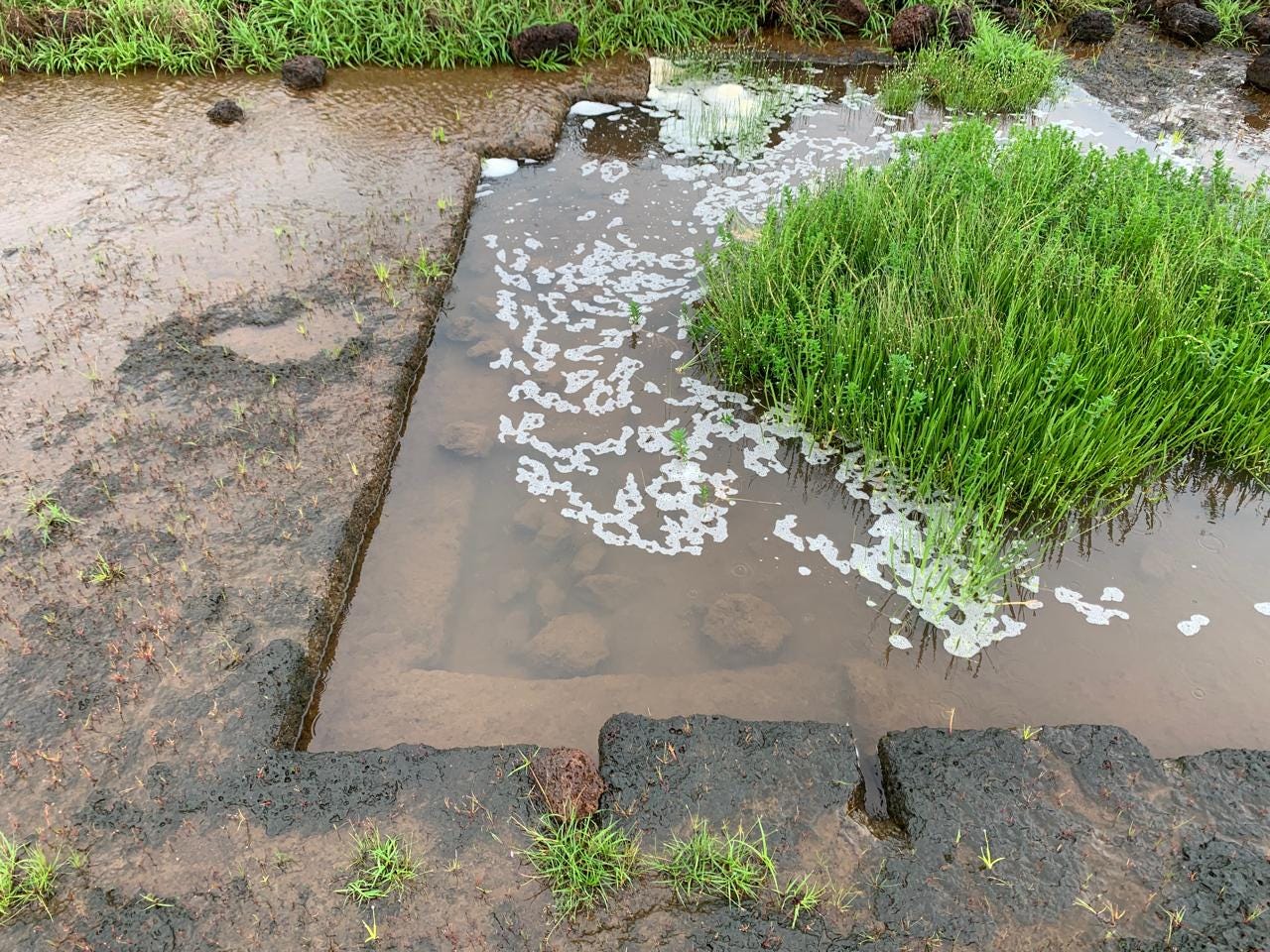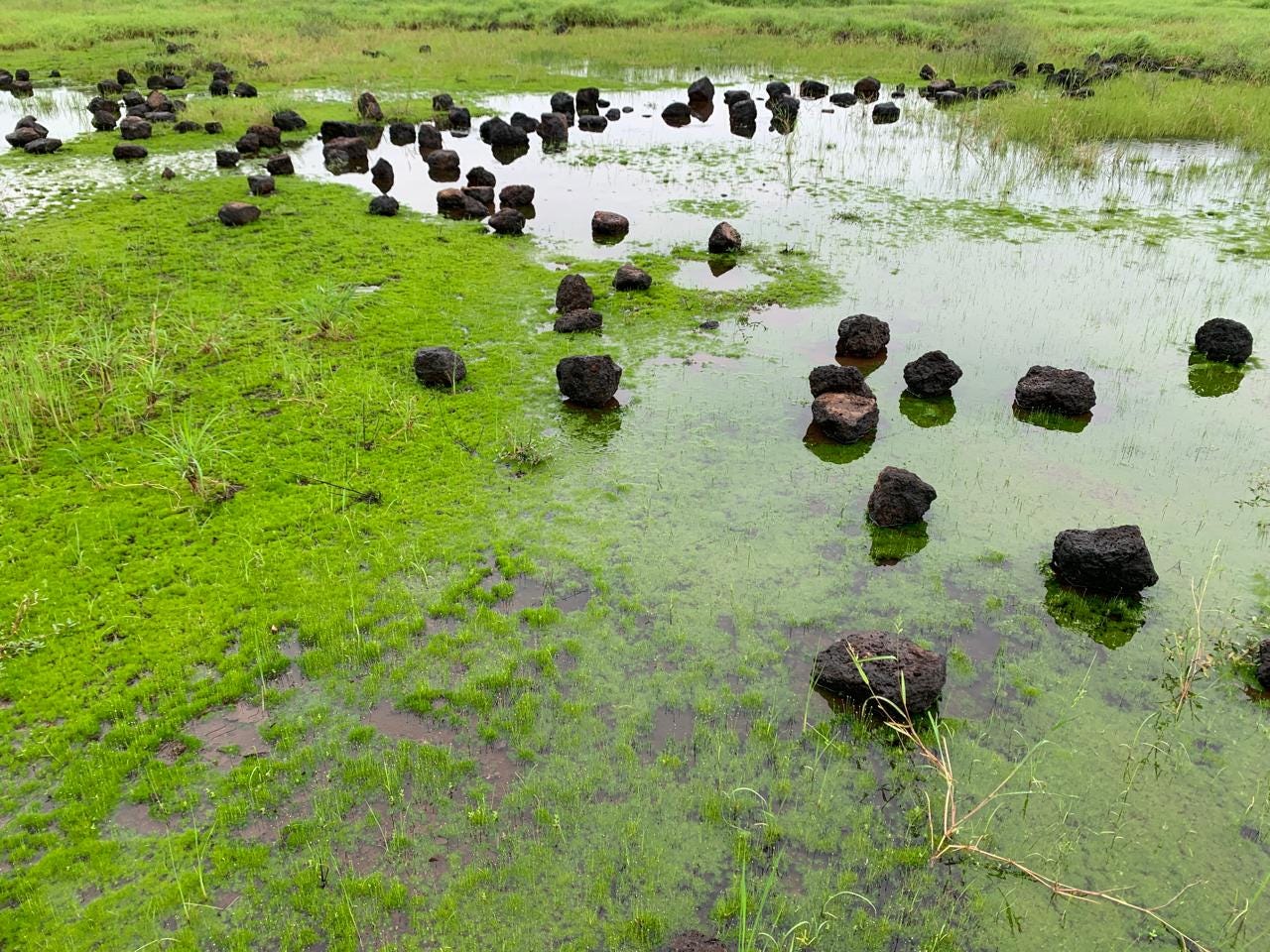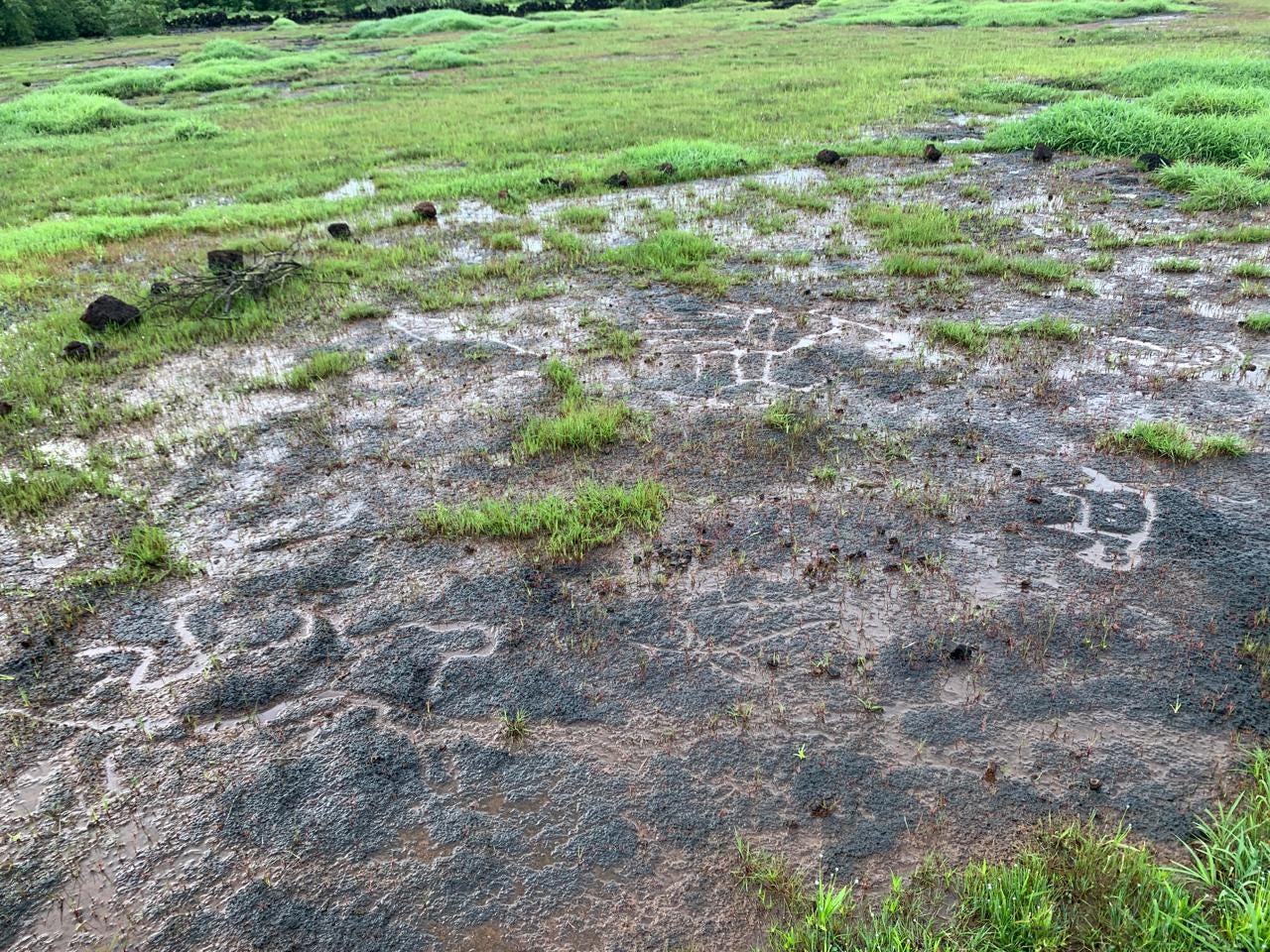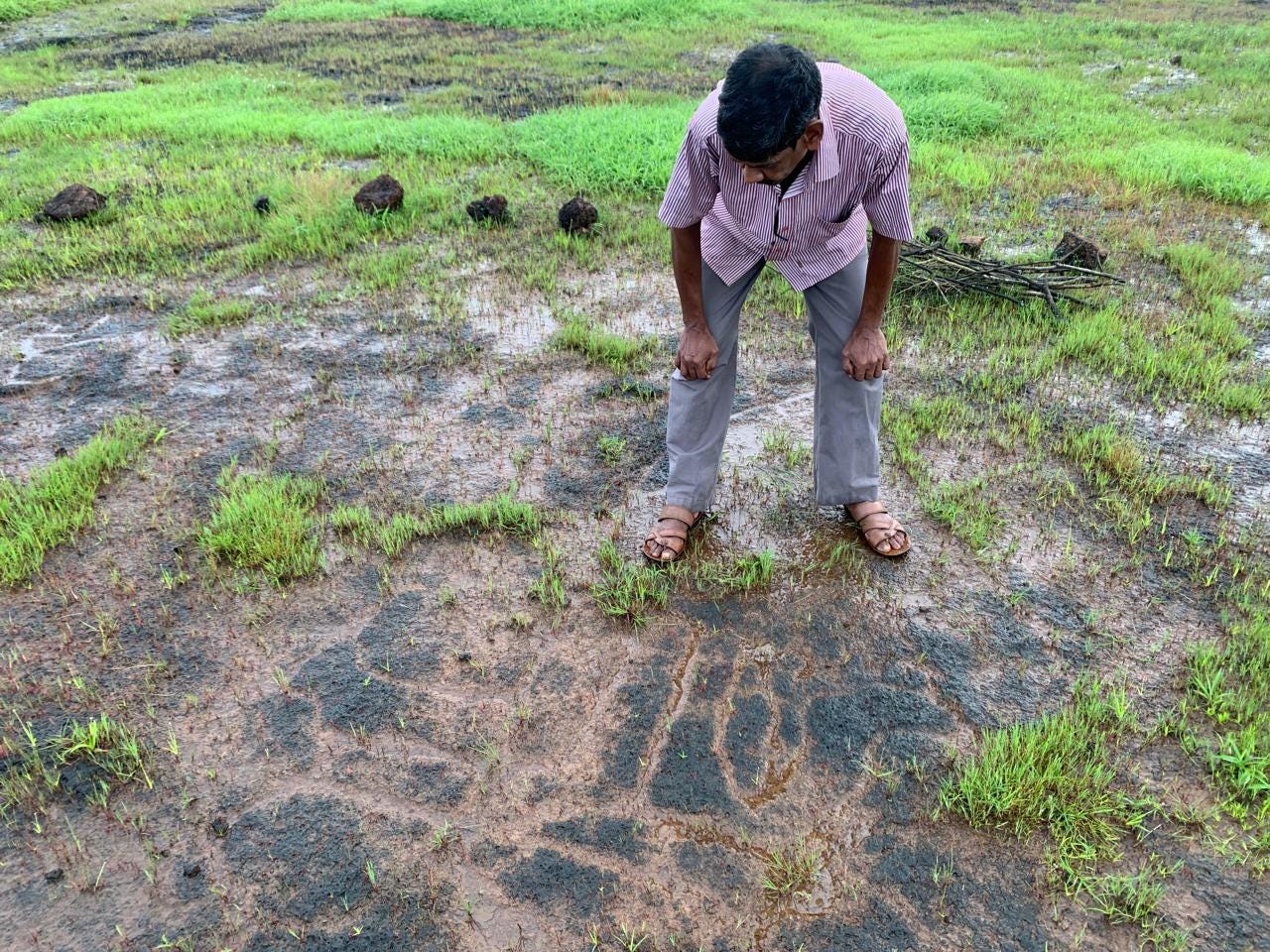What were the ancients thinking? What did man do when he wandered endlessly through the coasts and plains? How must have they given meaning to an otherwise meaningless existence? —I imagine them walking on a cold winter night, through the edges of the konkan coast. The full moon illuminating the sky. The sea reflecting that beautiful white light in the distance. Waves must have sounded the same as they do today. The flat land, on the top of the hill, that we now call “sada” must be endless back then. Wild grass must have covered the entire landscape, leaving only some room for trees to grow at the edges. The volcanic black rock underneath, created from the explosion of a long lost volcano, some millions, if not billions years back, making a hard surface for the ancients to walk on. Was leather introduced by then? Maybe! Maybe they had leather sandals, or maybe they walked barefoot. Whatever it was, I always wonder what they must have thought about life? What did it mean for them to be alive?
This was long before humans even created a concept called “God”. This is before humans invented time that trapped them into a mechanistic life. This is when the universe just was, without thoughts. Everything was happening and the ancestors, much like bees and the birds, were witnessing this ‘is’ness. This was the time when we simply walked from one place to another, trying to find someone like us. We slept in caves and protected ourselves from wild beasts. Were we alone, or were there more like us, wandering the endless horizon? Year after year, no sorry, there were no years back then. Infinitely they travelled, all while the continents shifted, islands emerged out of nowhere, volcanoes erupted, rivers appeared and disappeared. Were they conscious? Had they thought about a creator? ..or did they simply paint and inscribe that which they saw happening in front of them?
It is hard to answer any of these questions. The best we can do is speculate; make assumptions, but we can never go back to live that experience. But then, in some wild moments of momentary connection with the planet’s mind, that the Amazonian’s call ‘Gaia’, we can peep into the past. We remember that it is still that chunk of earth. Although the land has shifted its place, the sea has receded itself and the grassland is mowed down, we are still in the middle of that very space. Timeless, thoughtless, witnessing the ‘is’ness as it was, or rather, as it is.
Only that this time when we wander through the same grasslands, we see lights in all directions, cars rush past us through the cement roads that we built after extracting all that cement from the ground. As we wander, anxiety hits, we need to know what’s happening in the world, so we dive deep into the black screen which is inserted in our pockets by the ones who have stopped using them altogether. And once that we are in it, we sway with each stimuli that it transmits into our ever changing brain. That moonlight reflecting on the surface of the sea, still intact, yet we, watching someone’s past (or present) captured through a lens, on that black screen. Envying, laughing, jealous, getting angry, riddled with anxiety— it shows us our past, our future and yet our present lost, totally. Our connection to the earth, forgotten. The ‘is’ness; gone.
I was reminded of this when I first came across a news article, “Prehistoric art hints at lost Indian civilisation.” This article written in 2018 caught my eye, because the place they were talking about was Ratnagiri, which is some 40 kilometre from our village. It had not one, but hundreds of petroglyphs lying about on its flat volcanic surface - ‘sada’. A marvel of the ancient man, captured by him, portraying that what he witnessed. It contained many creatures; elephants, birds, whales, tortoise, human shapes. I was in Cheltenham at the time.
To summarize, I grew up within the vicinity of some of the most ancient rock carvings and I had never even heard about it!
It did not come as a surprise, that not a single person from my neighbourhood knew about it. Indian history is about wars, about triumph, about Hindus, Muslims and the consequent British conquest— it is no wonder then that a 10,000 year old rock carving was hardly finding any appreciative audience. It is better to forget these thousands of year old history because its not pushing a Hindu nor a Muslim agenda forward. It doesn’t talk about a specific belief or an ideology, instead it hints at a much more wild human past. Neglect was all it got. And although a few people were running around to find more such carvings in a bid to preserve them, each new finding brought a new problem. The owners of the land upon which these petroglyphs lay were reluctant in having this unwanted attention. In a fear that the Archaeological Department might seize their land, they were destroying these murals by digging the earth or by building walls around it and over it. A piece of art made by the ancient man some 10-20,000 years back, which withstood storms, fires, pouring rain— destroyed within days after being found.
What if no one would have found them? I like to think that this history would have been intact for many centuries to come. After all the wars were fought in the name of ideology and religion and after millions would have died, how beautiful would it have been to find these murals, made by humans who had none of that to start with. All emerging from a single point of reference. All one and the same— created in the image of that what we call ‘God’…
It was a rainy afternoon when I left for Chiplun. I had decided to take the odd routes in a quest to find some odd things. For centuries, people have dug the reddish volcanic rock, called “chira”, to use as a building material. Many square-shaped holes in an otherwise flat surface are littered all over the Konkan region. I was driving my uncle’s grey Tata. Careful in avoiding the potholes that the downpour had managed to create, I took a left and entered a narrow road. By the looks of it, it felt as if no one had cared to use this road. Other than the occasional old men and women walking on the sides of the road, wearing muddied off-white clothes, holding a stick, there was no one else to be found. The flat surface on both sides of the road was covered with shrubs, which from afar looked like a green carpet. Water that trickled down from the sky, flowed in all directions to find the nearest stream, which met the river, which then finally met the estuary. Square-shaped holes were easy to find in such a setting. They were always filled with water. These stone excavations served a double purpose; one was building houses and the other was a tank to hold water. Whenever I came across such man-made pond, I would park the car on the roadside and walk there to examine it; it’s depth, it’s cuts. In one such place, an old man, who was walking past, looked at me, giving me a maddening look.
“What’s in there?” he asked.
“Nothing. I am watching the hole”, I said.
I know, this means nothing to him. It’s simply a place to excavate rocks. What’s so special about it?
“These were made by our ancestors some 4-500 years back. Nothing to marvel upon!”, he reminded me.
I knew this, but the article about the petroglyphs had been running on my mind. I knew that our village was in the same stretch of land where these petroglyphs were found and there might be some here, waiting to be discovered.
“They look beautiful when filled with water, don’t they?” I exclaimed.
He laughed and moved along. Maybe his eyes were accustomed to this square-shaped hole. Maybe there was no beauty left in it for him.
Turtles were diving into the water. Tiny fish had made this pond their home. I wonder how they find this place. It’s dry throughout the summer, with temperatures surging up to 45 degrees and yet when monsoon arrives, these ponds come alive with fish, turtles and frogs.
After three hours of stop and search, I finally decided that it was time to move along. Maybe I should continue this search some other time. So I took the next exit which connected me to the highway.
A vadapav (sort of an Indian burger) store caught my attention. Hours of walking around had made me hungry. I reached out to my pocket, to get some cash, and that’s when I realised that there was no trace of my wallet. I remembered quite well that I had put it in my back pocket when I left Narvan, but now, there was nothing but empty air. I hadn’t even felt the lack of pressure on my right butt cheek, which this wallet usually created. Somewhere along the way I had dropped it and I had stopped at many places along the way. I had walked through the open spaces, bits of jungle and along the square-shaped holes. In a frenzy, I called my grandpa.
“I have lost my wallet”, I said.
“If it is somewhere where you walked, then you should be able to find it. There aren’t a lot of people in the villages and no one cares to walk through the flat land these days. Drive back and we will figure something out”, he had a tone of confidence in his speech and that was enough to make me hope, that I would find it back. It wasn’t just cash that I was worried about, the wallet also contained a lot of important documents.
I drove back to my village. Sanju dada was waiting for me. As I walked out of the car, he was ready to receive me with laughter, mocking me about the missing wallet. I tend to forget a lot. Sometimes my wallet, sometimes my bike/car keys or at other times my charger.
Grandpa took out a book from his book shelf. Dust had accumulated on its surface. It looked as if no one had looked after this book for years, not even grandpa. Just after his retirement, grandpa had managed to learn the art of reading horoscope, in order to keep him busy in this village. He had successfully read horoscopes of many in the village. As the word spread around, people from the surrounding villages came to him to consult him about marriages. The deal was thus, grandpa would look into the horoscopes and grandma would write it down. Owing to the Parkinson’s disease, writing was a tough task for grandpa. More about it here..
After going back and forth through a few pages, he prophesised, “The wallet should be lying around in the North-East direction and it should be next to a water source. Take Sanju along with you. You will definitely find it.”
Truth be told, I had walked a lot covering a vast expanse of land and the wallet could have fallen anywhere. Grandpa’s prophesy didn’t sit well with me. How would you find such a tiny wallet in an area spanning kilometres? I half-believed him and left off on the search with Sanju dada. We’d stop at each place where I had made a pit stop and walk around searching for a black wallet on the black surface of that volcanic rock. We walked around for almost two hours, scanning each and every place. Yet, there was no trace of it anywhere. Finally I looked at Sanju dada and said, “ I think we should give up.” It felt as if we were searching a black needle on a black floor. It was next to impossible to find it.
The sun had come out from the clouds when we started walking back to the car. That’s when I saw something shining in the distance. Curious, I walked in that direction. There it was, lying next to a square-shaped pond— next to a water source, in the north-east direction. My wallet had a tiny piece of metal which had it’s company name inscribed on it. Sanju dada had moved along, reaching almost to the car. I screamed out of joy, “Sanju dada, I found it. Grandpa was right.”
But that’s not the only thing that we found that day. While walking back, we stumbled across some unusual carvings. Oblivious to the fact that this could be a historic find, we scraped some soil from the top of these carvings with the help of a stick. What it revealed was almost unbelievable! We had, by sheer coincidence, stumbled across an undiscovered petroglyph— presumably 10-15,000 years old!
I will write more about it’s importance, it’s neglect and the effects of industrialisation on these archaeological sites in the next one..
Thanks for reading. If you are still here, I would take this moment to direct your attention to a book I have written. This book is almost 2 years in the making. In 2022 I left off on a walk across India and ended up walking 1800 km from Narvan on the west shore, to Visakhapatnam on the east shore. Initially to document the issues plaguing rural India, the project unfolded to become an unforgettable voyage of self-discovery; involving sleeping in unfamiliar places, venturing alone through the Naxalite insurgent jungles, and even being interrogated in a jail cell.
After contemplating on what is the right way forward, I have come to the conclusion that I will self-publish it- and I did. If you are interested in reading about my journey and supporting me to become a full-time writer, please consider buying “Journey to the East”- which is currently available through my website. www.ashutoshjoshi.in
If you would like to help me out in other ways, you can buy me a coffee via paypal, www.paypal.me/ashutoshjoshistudio. You would think that a couple of dollars/pounds won’t mean much, but it does, especially in India where it is difficult to make ends meet as an artist.
You can buy my first book “Journey to the East”, a memoir about an 1800 km walk through India, through my website .
If you would like to buy prints of my photographs, you can choose the photographs you like on my website and send me an email. I will send you custom quotes for the sizes you’d like.










Sorry, but speculation about the distant past is as specious as speculation about horoscopes and psychology.
Thank you so much. Every glimpse into the distant past is important, simply to remind ourselves that (1) our ancestors really existed, and we did not appear out of nothing when industrialization came into being, and (2) to give us hints about where we came from. Congratulations on your find! And thanks for sharing it with us!
BTW, the concept of time began far before written language, and (I believe) before anyone perceived themselves as separate from the natural world. The seasons alone would be something our prehistoric ancestors would have paid very close attention to. After all, the animals do, why not us? There are all the prehistoric stone megaliths that line up with summer / winter solstices on various continents. And there are ancient bone calendars dating as far back as 20,000 years ago, with tallies carved into it, some recording a woman's regular cycle, or a lunar cycle.
And we still obsess about time, however, today the fallacy is that we think that by measuring time (or the seasons, or the weather), we can control it. No, we can't. But even in that we're not so different from our distant ancestors, who undoubtedly asked their deities to give them good hunting, good weather, good... anything, and thought that the right rituals might / would provide it. At least, that's what they did on the oracle bones in Shang Dynasty China (ca 1050-1200 BC).